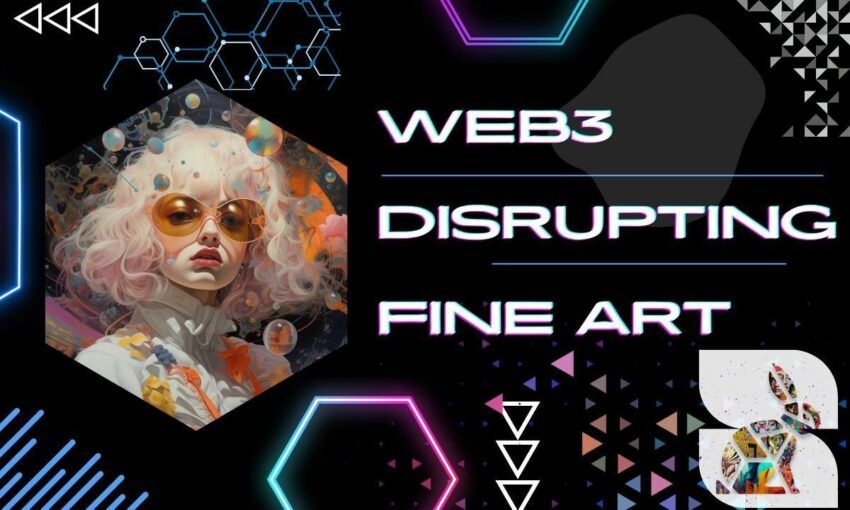Change is afoot in the art world, and it’s been a long time coming. Unsurprisingly, the shift pertains to digital natives, the fine art market’s key driving force for innovation. The question is, how can Web3 disrupt the fine art market?
New Ways of Thinking, New Era Dawning
In many ways the traditional art market has been somewhat disconnected from the ordinary man in the street, be it art sellers, art buyers or even artists themselves. Despite being ripe for change, the barriers of exclusivity and hostility are making it difficult to penetrate, and the key actors in that market are doing very little to shake up the status quo. It was only with the advent of digital technology that innovations started seeping in.
The generational gap is arguably nowhere more apparent, than in the realm of fine arts, and this is largely due to the financial, social and cultural influence of the digital natives. A new generation of investors is reclaiming art as an asset class and helping the space transcend its previous barriers.
The newer generations of creators and collectors are the art market’s movers and shakers. Technology is second nature to them, and they have readily embraced its rapid development in recent years. The art market has not been immune to these powerful changes.
Now that the art market is no longer severed from our tech-infused reality, we’re beginning to see the effects of this change. Technology is making it easier for emerging artists to come into the limelight. Through technology, a new generation of art lovers get to inject exciting new experiences such as virtual events and live streams of artists at work.
What’s the Matter with the Fine Art Market?
At present, the total fine art market is worth $68 billion, according to the 2023 Art Basel and UBS Art Market Report. Additionally, art has a low correlation to traditional markets. As per a 2022 CitiBank report, most correlations between blue-chip contemporary art and other asset classes are weakly positive or close to zero.
The Contemporary Art Market Report by Art Price, which provides an overview of 20 years of Contemporary Art auction history, found that the average price of a contemporary artwork has tripled between 2000 and 2019, which is why Contemporary Art is driving the growth of the global Art Market.
But the art market is also marred by issues for the average art collector with common barriers to entry being high costs, low liquidity, difficulty of access, lack of transparency, and an oligopoly held by a few key players. The space is also rife with money laundering and dubious actors, which add to a collector’s risk.
The average art collector has limited access to art, with geography and proximity limiting their choice to locally available or online.
These challenges make the art market unappealing and appear opaque and hostile for investors, enthusiasts, and collectors alike. The unfortunate knock on effect of such market conditions make life exceedingly difficult for lesser known artists trying to break through and grab the attention of an already limited art audience.
For an emerging artist, it can be next to impossible to get noticed and build a following for their work. Favoritism and nepotism are running rampant in the fine art market, and getting your work noticed or listed in a gallery is more about whom you know. Even for those lucky few that do manage to get their work into a gallery, the scales are not very favorable, as in most cases these artists forgo a 50% commission on the sale of an artwork.
Taking the Fine Art Market Online
The art market started undergoing a radical change with the introduction of online art sales, which in turn paved the way for global accessibility. The emergence of the online art market has been a major growth engine:
- According to the Hiscox Online Art Trade Report 2023, the online art market was worth $10.8 billion in 2022, as opposed to just $1.6 billion in 2012. This is a remarkable feat in just over a decade, considering the fact that e-commerce was still in its infancy at the beginning of the 21st century.
- A 2022 survey of high net-worth collectors even showed that the vast majority of them (95%) had, at some stage, bought works of art without viewing them in person beforehand.
- As per Citibank report, 91% of “Next-Gen collectors”, currently the driving force of the art market, buy art online.
A Paradigm Shift
An emerging generation of artists is actively using technological innovations to fight for their cause and play an active part in redefining the art market. Artists with shared goals and vision are seeking ways to collaborate, despite being scattered across the globe, and thrive in the new art market landscape.
The evolution of the fine art market has been slow, but now that technology is evolving faster than ever, and digital natives are running the show, its future looks promising. The much too abstract, buzzword concepts of NFTs and metaverse may have found the art community to be a tough crowd. But there are many other avenues to pursue to change the status quo radically.
The savvy new audience is in pursuit of quality content that can be easily accessed but also one that takes things a step further. They will not settle for the role of passive recipients. They want exquisite content that offers something else entirely: an immersive experience that is personalized, tangible and engaging.
Because new artists are more attuned to these expectations and demands, they can deliver this far more substantial experience and build a much more meaningful rapport with their following.
The role of the modern artist is to advocate for social causes they are passionate about. The new generation of art lovers is looking to cultivate a more personal relationship with artists. They are passionate about the artists who are not just talented, hard-working creators, but who also share their own values and social causes. While centered around their artistic work, the message artists send is multifaceted.
Creating Content to Keep the Community Glued to their Seats
If they are to grab attention in the competitive art world, the artists need to leverage all assets at their disposal. Some will stick to Instagram, others will take to TikTok, but for many artists, this type of exposure is too generic to generate any real publicity. They want to forge a more profound connection with each member of their audience.
New generations of discerning art enthusiasts and art creators all want to be part of an interactive community instead of fitting into current norms and status quo. The age of the internet and especially Web3, has breath of fresh air to a stodgy stale room. People don’t have to be there at the same place, but they get to be there at the same time.
The Transformative Potential of Web3
Web3 is turning into an indispensable vessel for the promotion of digital and physical art. Web3 promises to take things to the next level through blockchain technology, tokenization and fractionalization, which could have profound implications on the future of the global art community as we know it.
Many artists and art collectors have experienced first-hand what it means to be denied opportunities to even get a foot in the door. This is where the global nature of this Web3-driven art market, where the focus is on art, not the artist’s background, comes into play. The vision is to give artists a level playing field and equal growth opportunity.
Blockchain, with its real-world applications, has stood the test of time and it is gradually becoming mainstream. It is facilitating the transition of art into a widespread commodity, whether in the form of art fractions, art tokens, or other collectibles. In a way, this exclusive access to collectibles is a refined form of art collecting for the new generation.
Established brands are joining in and bringing real-world assets onto the blockchain. Now that a new era in the visual arts is upon us, Web3 is bridging the gap between the community and young artists seeking to build an audience, and in doing so, giving this emerging art community a shared goal and a place to gravitate toward.
A Different Type of Networking
The world of art is evolving to become more approachable, accessible and accepting. Emerging artists who want to grow are naturally compelled to look for alternatives.
Some of them can certainly still do so through live or heavily publicized events, but others are denied these opportunities. Taking their art online and turning how they communicate with their audience into an immersive experience allows them to craft their own community and following.
What artists need is a more personal virtual space in which to showcase their talent, attract a broader audience with which to connect, and build a sustainable network on their own terms.
The Power of the People
The community-driven nature of Web3 has made it a favorable environment for buzzing new platforms with more hands-on engagement. What has so far been missing from the space is an artist-led platform built for and created by artists, an art community continuously in the making.
It would be a place that art creators and art lovers would flock to, one that would give broader audiences access to works of art, and provide artists with more financial and creative freedom and independence. Angelo is one such platform. It is designed as a mixture between a self-publishing platform, much like Amazon’s Kindle Direct and a social streaming platform like Twitch.
For emerging artists in search of a platform that allows them to express their creative self to a community of art enthusiasts and collectors, look no further.
Disclaimer
This article is sponsored content and does not represent the views or opinions of BeInCrypto. While we adhere to the Trust Project guidelines for unbiased and transparent reporting, this content is created by a third party and is intended for promotional purposes. Readers are advised to verify information independently and consult with a professional before making decisions based on this sponsored content. Please note that our Terms and Conditions, Privacy Policy, and Disclaimers have been updated.


